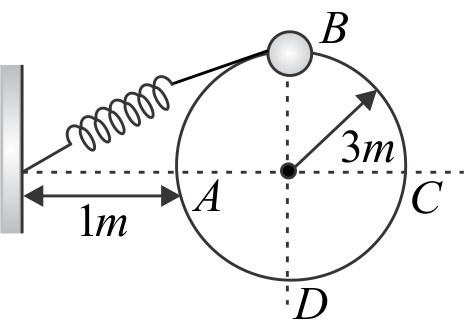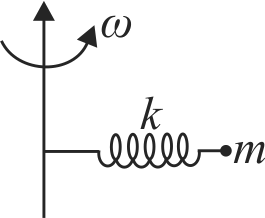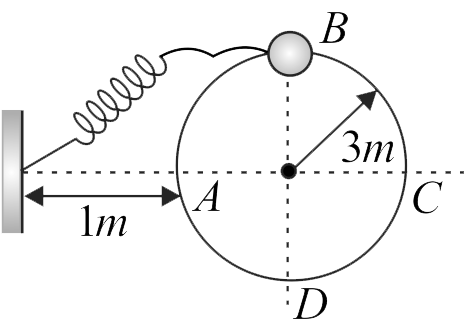355599
A bead of mass \(150\,g\) is constrained to move along a vertical smooth and fixed circular track of radius \(3\,m\) as shown in figure is released at \({B}\). The spring is in the plane of the track has natural length of \(1\,m\) and spring constant of \({3 / 16 {~N} / {m}}\). It starts from rest at \({B}\). What is the normal force exerted by the track on the bead when it passes through \({A}\)?
355600
A particle of mass \(m\) is fixed to one end of a light spring of force constant \(k\) and unstretched length \(l\). The system is rotated about the other end of the spring with an angular velocity \(\omega\), in gravity free space. The increase in length of the spring will be
355599
A bead of mass \(150\,g\) is constrained to move along a vertical smooth and fixed circular track of radius \(3\,m\) as shown in figure is released at \({B}\). The spring is in the plane of the track has natural length of \(1\,m\) and spring constant of \({3 / 16 {~N} / {m}}\). It starts from rest at \({B}\). What is the normal force exerted by the track on the bead when it passes through \({A}\)?
355600
A particle of mass \(m\) is fixed to one end of a light spring of force constant \(k\) and unstretched length \(l\). The system is rotated about the other end of the spring with an angular velocity \(\omega\), in gravity free space. The increase in length of the spring will be
355599
A bead of mass \(150\,g\) is constrained to move along a vertical smooth and fixed circular track of radius \(3\,m\) as shown in figure is released at \({B}\). The spring is in the plane of the track has natural length of \(1\,m\) and spring constant of \({3 / 16 {~N} / {m}}\). It starts from rest at \({B}\). What is the normal force exerted by the track on the bead when it passes through \({A}\)?
355600
A particle of mass \(m\) is fixed to one end of a light spring of force constant \(k\) and unstretched length \(l\). The system is rotated about the other end of the spring with an angular velocity \(\omega\), in gravity free space. The increase in length of the spring will be
355599
A bead of mass \(150\,g\) is constrained to move along a vertical smooth and fixed circular track of radius \(3\,m\) as shown in figure is released at \({B}\). The spring is in the plane of the track has natural length of \(1\,m\) and spring constant of \({3 / 16 {~N} / {m}}\). It starts from rest at \({B}\). What is the normal force exerted by the track on the bead when it passes through \({A}\)?
355600
A particle of mass \(m\) is fixed to one end of a light spring of force constant \(k\) and unstretched length \(l\). The system is rotated about the other end of the spring with an angular velocity \(\omega\), in gravity free space. The increase in length of the spring will be

